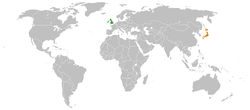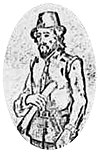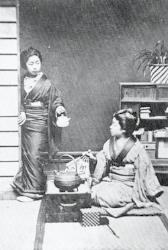Japan–United Kingdom relations
 | |
United Kingdom |
Japan |
|---|---|
The history of the relationship between the United Kingdom and Japan began in 1600 with the arrival of William Adams (Adams the Pilot, Miura Anjin) on the shores of Kyūshū at Usuki in Ōita Prefecture. During the Sakoku period (1641–1853), there were no relations between the two countries, but the treaty of 1854 saw the resumption of ties which, despite a hiatus during the Second World War, remain very strong up until the present day.On May,3,2011 British Foreign Secretary William Hague said that Japan was to the United Kingdom "unquestionably our closest partner in Asia".
Chronology of Anglo-Japanese relations
- 1587. Two young Japanese men named Christopher and Cosmas sailed on a Spanish galleon to California, where their ship was seized by Thomas Cavendish. Cavendish brought the two Japanese men with him to England where they spent approximately three years before going again with him on his last expedition to the South Atlantic. They are the first known Japanese men to have set foot in England.

- 1600. William Adams, a seaman from Gillingham, Kent, was the first Englishman to arrive in Japan. Acting as an advisor to the Tokugawa Shogun, he was renamed Miura Anjin, granted a house and land, and spent the rest of his life in his adopted country.
- 1605. John Davis, the famous English explorer, was killed by Japanese pirates off the coast of Thailand, thus becoming the first known Englishman to be killed by a Japanese.[1]
- 1623. The Amboyna massacre occurred. After the incident England closed its commercial base at Hirado, now in Nagasaki Prefecture, without notifying Japan. After this, the relationship ended for more than two centuries.
- 1639. Tokugawa Iemitsu announced his Sakoku policy. Only the Netherlands was permitted to retain limited trade rights.
- 1673. An English ship "Returner" visited Nagasaki harbour, and asked for a renewal of trading relations. But the Edo Shogunate refused. The government blamed it on the withdrawal 50 years earlier, and found it unacceptable that Charles II of England married Catherine of Braganza, who was from Portugal, and favoured the Roman Catholic Church.
- 1808. HMS Phaeton enters Nagasaki to attack Dutch shipping.
- 1832. Otokichi, Kyukichi and Iwakichi, castaways from Aichi Prefecture, crossed the Pacific and were shipwrecked on the west coast of North America. The three Japanese men became famous in the Pacific Northwest and probably inspired Ranald MacDonald to go to Japan. They joined a trading ship to the UK, and later Macau. One of them, Otokichi, took British citizenship and adopted the name John Matthew Ottoson. He later made two visits to Japan as an interpreter for the Royal Navy.
- 1854. 14 October. The first limited Anglo-Japanese Friendship Treaty between the United Kingdom and Japan was signed by Admiral Sir James Stirling and representatives of the Tokugawa shogunate (Bakufu).
- 1855. In an effort to find the Russian fleet in the Pacific Ocean during the Crimean war, a French-British naval force reached the port of Hakodate, open to British ships as a result of the Anglo-Japanese Friendship Treaty of 1854, and sailed further North, seizing the Russian-American Company's possessions on the island of Urup in the Kuril archipelago. The Treaty of Paris (1856) restitutes the island to Russia.[2]
- 1858. 26 August. The Anglo-Japanese Treaty of Amity and Commerce was signed by the Scot Lord Elgin for the United Kingdom and representatives of the Tokugawa shogunate for Japan, after the Harris Treaty was concluded.
- 1861. 5 July. The British legation in Edo was attacked and Laurence Oliphant was wounded.

- 1862. The Shogun sends the First Japanese Embassy to Europe, led by Takenouchi Yasunori.
- 1862. 14 September. The Namamugi Incident occurred within a week of the arrival of Ernest Satow in Japan.
- 1863. Bombardment of Kagoshima by the Royal Navy. (Anglo-Satsuma War).
The Chōshū Five go secretly to England.
- 1864. Bombardment of Shimonoseki by the United Kingdom, France, the Netherlands and the USA.
- 1867. The Icarus affair, an incident involving the murder of two British sailors in Nagasaki, leading to increased diplomatic tensions between Britain and the Tokugawa shogunate.
- 1872. The Iwakura mission visited the United Kingdom as part of a diplomatic and investigative tour of the United States and Europe.
- 1873. The Imperial College of Engineering opened with Henry Dyer as principal.

- 1885–87. Japanese exhibition at Knightsbridge, London.[3]
- 1891. The Japan Society of London is founded by Arthur Diosy.
- 1894. The Anglo-Japanese Treaty of Commerce and Navigation was signed in London on 16 July. The treaty abolished extraterritoriality in Japan for British subjects with effect from 17 July 1899
- 1896. The Greek-born Northern Irish writer Lafcadio Hearn (KOIZUMI Yakumo), a British citizen, becomes a Japanese national.
- 1902. The Anglo-Japanese alliance was signed in London on 30 January.
- 1905. The Anglo-Japanese alliance was renewed and expanded.
- 1908. The Japan-British Society was founded in order to foster cultural and social understanding.
- 1911. The Anglo-Japanese alliance was renewed.
- 1913. The IJN Kongō, the last of the British-built warships for Japan's navy, enters service.
- 1914. Japan joined World War I as the United Kingdom's ally under the terms of the alliance and captured German-occupied Tsingtao (Qingdao) in China Mainland.
- 1921. Crown Prince Hirohito visited the UK and other European countries, via Singapore. It was the first time that a Japanese crown prince had traveled overseas.
- 1921. Arrival in September of the Sempill Mission in Japan, a British technical mission for the development of Japanese Aero-naval forces.
- 1923. The Anglo-Japanese alliance was officially discontinued on 17 August after U.S. pressure and other factors brought it to a close.
- 1939. The Tientsin Incident almost causes an Anglo-Japanese war when the Japanese blockade the British concession in Tientsin, China.
- 1941–1945. Japan enters World War II as an enemy of the British Empire and captures British colonies Malaya, Burma, Hong Kong and Singapore. Many British POWs die in Japanese captivity.
- 1948. The 1948 Summer Olympics was held in London. Japan did not participate.
- 1951. Treaty of San Francisco – the peace treaty in which Anglo-Japanese relations were normalized. One condition of the treaty was Japan's acceptance of the judgments of the Tokyo War Crimes Tribunal (Article 11).
- 1963. The University of Oxford set Japanese as a subject in its Oriental Institute (the Sub-Faculty of East Asian Studies).
- 1966. The Beatles played at Nippon Budokan in Tokyo to overwhelming adulation. This performance emphasized growing good will between Britain and Japan in their foreign relations policies.
- 1971. HIM Emperor Hirohito pays a state visit to the United Kingdom after an interval of 50 years.[4]
- 1975. HM Queen Elizabeth II of the United Kingdom pays a state visit to Japan.[5]
- 1978. Beginning of the BET scheme (British Exchange Teaching Programme) first advocated by Nicholas MacLean.[6]
- 1983. Naruhito (now Japan Crown Prince) studied at Merton College, Oxford until 1985, and researched transport on the River Thames.
- 1986. Nissan Motors began to operate its car plant in Sunderland, as Nissan Motor Manufacturing (UK) Ltd.
- 1986. Charles, Prince of Wales visited Japan with his wife, Diana.
- 1987. JET (Japan Exchange and Teaching) program starts when the BET scheme and the Fulbright scholarship are merged.
- 1988. The Daiwa Anglo-Japanese Foundation established.
- 1990. The Alumni Association for British JET Participants JETAA UK is established
- 1991. The first Sumo tournament to be held outside Japan is hosted at the Royal Albert Hall in London.[7]
- 1998. HIM Emperor Akihito pays a state visit to the United Kingdom.[4][8]
- 2001. The year-long "Japan 2001" cultural-exchange project saw a major series of Japanese cultural, educational and sporting events held around the UK.
- 2008. UK-Japan 2008 celebrates the 150th anniversary of the Anglo-Japanese Treaty of Amity and Commerce.[9]
- 2011. UK sends over rescue men with rescue dogs and supplies to help the Japanese, after the earthquake.
See also the chronology on the British Embassy website in Tokyo.[10]
Britons in Japan
- William Adams (Miura Anjin)
- Rutherford Alcock, diplomat
- William George Aston, consular official and Japanologist
- William Edward Ayrton, Professor of physics & telegraphy
- Thomas Baty, legal adviser.
- Felice Beato – British/Italian/Corfiote photographer
- Isabella Bird – Victorian traveller and author
- John Reddie Black, publisher of newspapers
- Duncan Gordon Boyes – winner of the Victoria Cross at Shimonoseki, 1864
- Richard Henry Brunton, Father of Japanese lighthouses
- Basil Hall Chamberlain, Professor and Japanologist
- Edward Bramwell Clarke, Professor who helped introduce rugby to Japan
- Samuel Cocking – Yokohama merchant
- Josiah Conder, architect
- Hugh Cortazzi, scholar and former ambassador
- James Main Dixon (1856–1933). Former FRSE. After teaching at the Imperial University of Tokyo, he moved to the University of South California.
- Archibald Douglas, leader of a naval mission to Japan in the early 1870s
- Henry Dyer, first principal of the Imperial College of Engineering (Kobu Daigakko)
- Lord Elgin, signed the 1858 treaty
- James Alfred Ewing, Professor
- Hugh Fraser, British minister 1889–94
- Thomas Blake Glover, Scottish trader
- Abel Gower, consul
- William Gowland, 1842–1922, Father of Japanese archaeology
- Thomas Lomar Gray, engineering professor
- Arthur Hasketh Groom, creator of the first golf course in Japan
- John Harington Gubbins, diplomat
- Joseph Henry Longford, consul and academic
- Claude Maxwell MacDonald, diplomat
- Ranald MacDonald, the first English teacher in Japan
- John Milne, Professor and Father of Seismology
- Algernon Bertram Mitford (Lord Redesdale), diplomat
- James Murdoch – eccentric teacher, journalist, historian
- Edward St. John Neale, Lt.-Col, Secretary of Legation then Chargé d'Affaires 1862–1863
- Laurence Oliphant – Secretary of Legation in 1861
- Henry Spencer Palmer – engineer and Times correspondent
- Harry Smith Parkes, diplomat
- David Peace, novelist, whose most recent novel are set in post-World War II Japan.
- John Perry, colleague of Ayrton at the Imperial College of Engineering, Tokyo
- Charles Lennox Richardson – slain in the Namamugi Incident
- Ernest Mason Satow, diplomat and Japanologist
- Alexander Cameron Sim – founder of Kobe Regatta & Athletic Club, introduced lemonade (ramune) to Japan.
- Admiral Sir James Stirling – signed the 1854 treaty
- Walter Weston, Rev. who publicised the term "Japanese Alps"
- William Willis, Dr.
- Charles Wirgman, editor of Japan Punch
The chronological list of Heads of the United Kingdom Mission in Japan.
Japanese in the United Kingdom
(see article Japanese in the United Kingdom).
The family name is given in italics. Usually the family name comes first, but in modern times not so for the likes of Kazuo Ishiguro and Katsuhiko Oku, both well-known in the United Kingdom.
- Aoki Shūzō – diplomat, signed the 1894 treaty in London
- Hayashi Tadasu
- Inagaki Manjirō, Cambridge University graduate and diplomat
- Kazuo Ishiguro
- Iwakura Tomomi – see Iwakura mission especially
- Kikuchi Dairoku, Cambridge University graduate and politician
- Mori Arinori
- Natsume Sōseki
- Katsuhiko Oku – Oxford University rugby player, diplomat in Japanese embassy in London who died in Iraq, 2003. Posthumously promoted to ambassador. See also the Oku-Inoue fund for the children of Iraq.
- Kishichiro Okura, entrepreneur
- Hisashi Owada, Cambridge University graduate, father of Princess Masako
- Suematsu Kenchō, Cambridge University graduate and statesman
- Ginnosuke Tanaka, Cambridge University graduate, introduced rugby to Japan
- Tōgō Heihachirō – the Nelson of the East
- Yamao Yōzō
- Taka Hirose, Bassist of the band Feeder
- Naoko Mori, actress – famous for playing Toshiko Sato in Torchwood and Doctor Who
List of Japanese diplomatic envoys in Great Britain (partial list)
Ministers Plenipotentiaries
- Terashima Munenori 1872-1873
- Kagenori Ueno 1874-1879
- Mori Arinori 1880-1884
- Masataka Kawase 1884-1893
- Aoki Shūzō 1894
- Katō Takaaki 1895-1900
- Hayashi Tadasu 1900-1905
Ambassadors
- Hayashi Tadasu 1905-1906
- Komura Jutarō 1906-1908
- Katō Takaaki 2nd time, 1908–1912
- Katsunosuke Inoue 1913-1916
- Chinda Sutemi 1916-1920
- Gonsuke Hayashi 1920-1925
- Keishiro Matsui 1925-1928
- Matsudaira Tsuneo 1929-1935
- Shigeru Yoshida 1936-1938
- Mamoru Shigemitsu 1938-1941
- Shunichi Matsumoto 1952-1955
- Haruhiko Nishi 1955-1957
- Katsumi Ōno 1958-1964
- Morio Yukawa 1968-1972
- Haruki Mori 1972-?
- Masaki Orita 2001-2004
- Yoshiji Nogami 2004-2008
- Shin Ebihara 2008–present
See also
- British Japan Consular Service
- o-yatoi gaikokujin – foreign employees in Meiji era Japan
- Foreign cemeteries in Japan
- Japan Society of London
- German–Japanese relations
- British Japanese, British people of Japanese descent
- Anglo-Chinese relations
- Iwakura mission
- gaikoku bugyō
- Chōshū Five
- Japanese students in Britain
Reference books
- Britain & Japan: Biographical Portraits, Volume V, edited by Hugh Cortazzi, Global Oriental 2004, ISBN 1-901903-48-6
- British Envoys in Japan 1859–1972, edited and compiled by Hugh Cortazzi, Global Oriental 2004, ISBN 1-901903-51-6
Notes
- ^ Stephen Turnbull, "Fighting ships of the Far East (2), p 12, Osprey Publishing
- ^ Thierry Mormane : "La prise de possession de l'île d'Urup par la flotte anglo-française en 1855", Revue Cipango, "Cahiers d'études japonaises", No 11 hiver 2004 pp. 209-236.
- ^ Information about 1885–87 Japanese exhibition at Knightsbridge
- ^ a b "Ceremonies: State visits". Official web site of the British Monarchy. Retrieved 2008-11-27.
- ^ "OUTWARD STATE VISITS MADE BY THE QUEEN SINCE 1952". Official web site of the British Monarchy. Retrieved 2008-11-25.
- ^ http://linguanews.com/php_en_news_read.php?section=s2&idx=2321
- ^ Penguin Pocket On This Day. Penguin Reference Library. 2006. ISBN 0-141-02715-0.
- ^ "UK: Akihito closes state visit". BBC News. 1998-05-29. Retrieved 2008-11-25.
- ^ http://www.ukjapan2008.jp/
- ^ http://www.uknow.or.jp/be_e/uk_japan/relations/
External links
- A Bibliography of Anglo-Japanese relations – at Cambridge University
- The Asiatic Society of Japan – in Tokyo
- The British Association for Japanese Studies
- The British Consulate – in Nagoya
- The British Consulate-General – in Osaka
- The British Council in Japan – the cultural arm of the British government overseas
- The British Chamber of Commerce in Japan
- The British Embassy – in Tokyo
- The British Trade Promotion Office in Fukuoka (closed June 2005)
- The Cambridge & Oxford Society – founded in Tokyo in 1905
- The Daiwa Anglo-Japanese Foundation – in London and Tokyo
- The Embassy of Japan – in London
- The Great Britain Sasakawa foundation – in London and Tokyo
- The Japan Society – founded in London in 1891
- The Japan-British Society – founded in Japan in 1908
- Japan-U.K. Relations at Japan's Ministry of Foreign Affairs Official Website.

